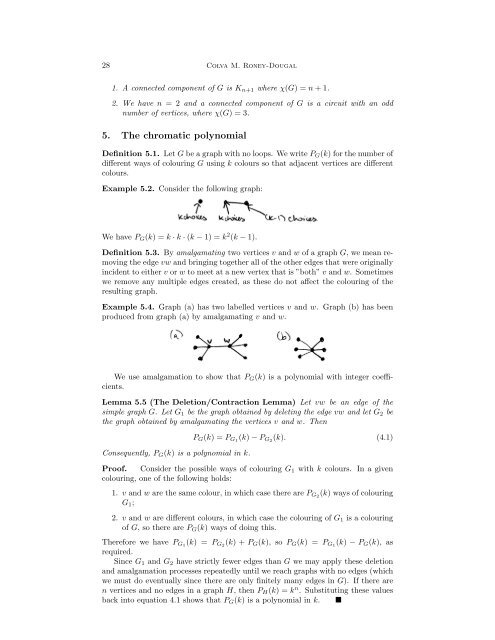You also want an ePaper? Increase the reach of your titles
YUMPU automatically turns print PDFs into web optimized ePapers that Google loves.
28 Colva M. Roney-Dougal1. A connected component of G is K n+1 where χ(G) = n + 1.2. We have n = 2 and a connected component of G is a circuit with an oddnumber of vertices, where χ(G) = 3.5. The chromatic polynomialDefinition 5.1. Let G be a graph with no loops. We write P G (k) for the number ofdifferent ways of colouring G using k colours so that adjacent vertices are differentcolours.Example 5.2. Consider the following graph:We have P G (k) = k · k · (k − 1) = k 2 (k − 1).Definition 5.3. By amalgamating two vertices v and w of a graph G, we mean removingthe edge vw and bringing together all of the other edges that were originallyincident to either v or w to meet at a new vertex that is ”both” v and w. Sometimeswe remove any multiple edges created, as these do not affect the colouring of theresulting graph.Example 5.4. <strong>Graph</strong> (a) has two labelled vertices v and w. <strong>Graph</strong> (b) has beenproduced from graph (a) by amalgamating v and w.We use amalgamation to show that P G (k) is a polynomial with integer coefficients.Lemma 5.5 (The Deletion/Contraction Lemma) Let vw be an edge of thesimple graph G. Let G 1 be the graph obtained by deleting the edge vw and let G 2 bethe graph obtained by amalgamating the vertices v and w. ThenConsequently, P G (k) is a polynomial in k.P G (k) = P G1 (k) − P G2 (k). (4.1)Proof. Consider the possible ways of colouring G 1 with k colours. In a givencolouring, one of the following holds:1. v and w are the same colour, in which case there are P G2 (k) ways of colouringG 1 ;2. v and w are different colours, in which case the colouring of G 1 is a colouringof G, so there are P G (k) ways of doing this.Therefore we have P G1 (k) = P G2 (k) + P G (k), so P G (k) = P G1 (k) − P G (k), asrequired.Since G 1 and G 2 have strictly fewer edges than G we may apply these deletionand amalgamation processes repeatedly until we reach graphs with no edges (whichwe must do eventually since there are only finitely many edges in G). If there aren vertices and no edges in a graph H, then P H (k) = k n . Substituting these valuesback into equation 4.1 shows that P G (k) is a polynomial in k.













